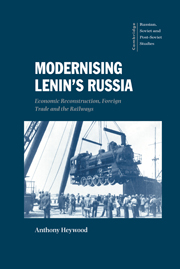Book contents
- Frontmatter
- Contents
- List of illustrations
- List of tables
- Acknowledgements
- Technical note
- List of abbreviations and acronyms
- Introduction
- PART I Towards economic reconstruction, 1917–1920 the birth of the railway imports policy
- 1 Prologue
- 2 The revolutionary railway vision
- PART II Trade and isolation, 1920–1921 implementing the railway imports policy
- PART III Retreat, 1921–1924
- Conclusion
- Notes
- Bibliography
- Index
- Cambridge Russian, Soviet and Post-Soviet Studies
- Plate Section
1 - Prologue
Published online by Cambridge University Press: 14 August 2009
- Frontmatter
- Contents
- List of illustrations
- List of tables
- Acknowledgements
- Technical note
- List of abbreviations and acronyms
- Introduction
- PART I Towards economic reconstruction, 1917–1920 the birth of the railway imports policy
- 1 Prologue
- 2 The revolutionary railway vision
- PART II Trade and isolation, 1920–1921 implementing the railway imports policy
- PART III Retreat, 1921–1924
- Conclusion
- Notes
- Bibliography
- Index
- Cambridge Russian, Soviet and Post-Soviet Studies
- Plate Section
Summary
Much of the explanation for the railway imports policy of 1920–4 must be sought in the Bolshevik leadership's economic strategy and assessment of the international situation in the winter of 1919–20. But the policy also had roots in the epoch prior to the October Revolution. The Bolshevik government was well aware that railway development had been among the most important driving forces of pre-war industrialisation between the 1860s and 1914, not least through the tsarist regime's policy of industrial protectionism. At the same time, the Bolsheviks knew that the foreign sector had always been important for the Russian railways, especially as a source of investment funds in the pre-war era and as a supplier of urgently needed equipment during the First World War. An overview of these issues will help to clarify the extent to which Bolshevik policy was shaped by precedents from the pre-Soviet period.
The pre-1914 context
The state-led industrialisation of Russia from the 1860s onwards was intended to create a modern, self-sufficient industrial economy quickly. It reflected not only the tsarist state's traditional preoccupation with overcoming Russia's economic backwardness relative to the West but also a growing realisation that, to quote Marks, ‘the road to power for nation-states in the nineteenth and twentieth centuries lay along the path of technological advance’.
- Type
- Chapter
- Information
- Modernising Lenin's RussiaEconomic Reconstruction, Foreign Trade and the Railways, pp. 13 - 47Publisher: Cambridge University PressPrint publication year: 1999

